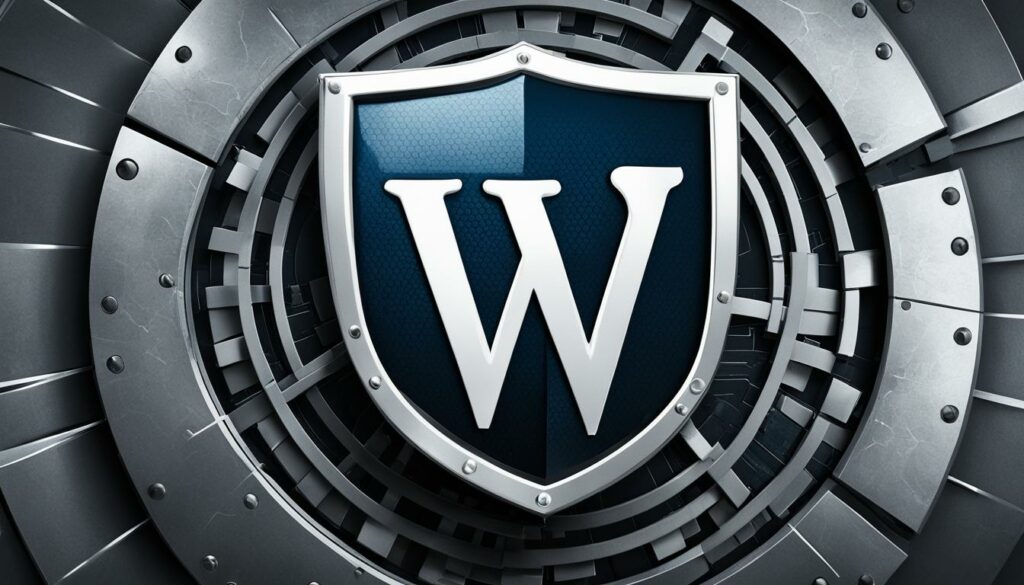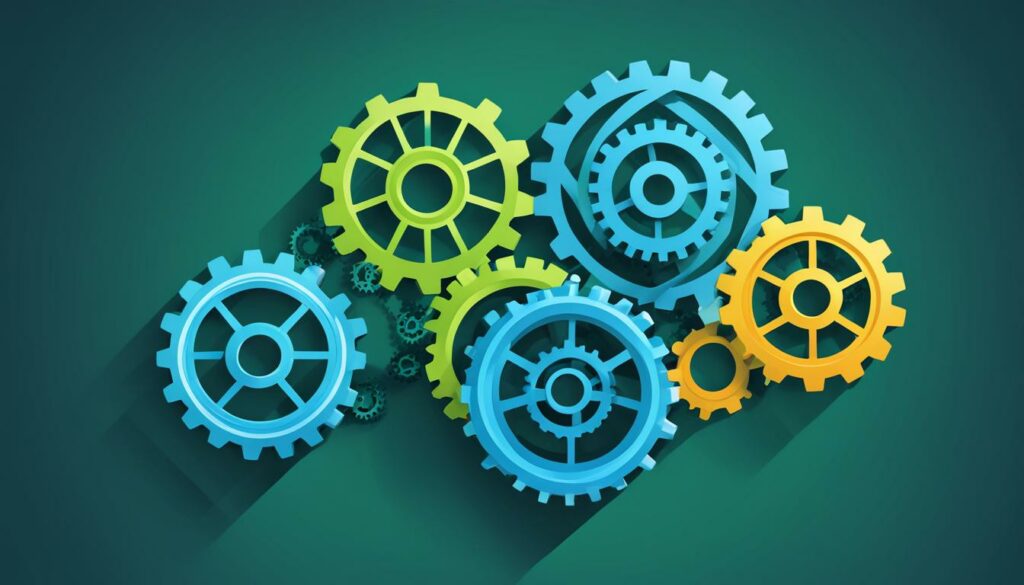Protecting your WordPress website is essential in today’s digital landscape. With the increasing threats of hackers and malware, taking proactive steps to ensure WordPress security is crucial. In this comprehensive guide, we will share advanced techniques and best practices that will help you protect your website and minimize the risk of security vulnerabilities.
Key Takeaways:
- Implementing WordPress security measures is vital to protect your website from potential attacks.
- Regularly updating WordPress core, plugins, and themes helps minimize security vulnerabilities.
- Using strong passwords and managing user permissions enhances WordPress security.
- Choosing a reliable web hosting provider plays a crucial role in maintaining website security.
- Implementing best practices such as enabling two-factor authentication and limiting login attempts strengthens WordPress security.
The Importance of WordPress Security
WordPress security plays a crucial role in safeguarding your website from phishing attacks, malware infiltrations, and other online security threats. With the increasing number of hacking incidents and the potential damage they can cause, prioritizing the security of your WordPress site is essential in protecting your business reputation and revenue.
Every day, thousands of websites are blacklisted by Google due to hosting malware or engaging in phishing scams. As a website owner, it is your responsibility to implement proper security measures to prevent your site from becoming a target. By taking proactive steps to enhance WordPress security, you can minimize the risk of being compromised by hackers and the associated repercussions.
“Thousands of websites are blacklisted by Google every day for hosting malware or engaging in phishing scams.”
By safeguarding your website, you ensure that your visitors can browse your content safely and securely. This builds trust, protects user data, and helps maintain a positive online experience. Taking preventive action is crucial, as addressing security breaches can be time-consuming, costly, and detrimental to your overall website performance.
Implementing WordPress security measures, such as regularly updating software, using strong passwords, and employing security plugins, can significantly reduce the risk of successful phishing attacks and malware infiltrations. Additionally, staying informed about the latest security trends and best practices empowers you to stay one step ahead of potential threats.
Protecting Your Business Reputation and Revenue
Unauthorized access to your WordPress site and the presence of malware can have severe consequences for your business. In addition to potential financial losses, your reputation may be tarnished, leading to a loss of customer trust and decreased revenue. Investing time and effort into implementing robust security measures is a proactive approach that helps ensure uninterrupted business operations and sustains long-term success.
Remember, your website acts as a digital storefront for your business, and its security should be treated with the same care and attention as physical security measures. By prioritizing WordPress security, you protect not only your website but also your brand image and customer relationships.
https://www.youtube.com/watch?v=rfJkfffImgk
The Consequences of Neglecting WordPress Security
Neglecting WordPress security puts your website and the sensitive information it holds at risk. The consequences of security breaches can include:
- Loss of sensitive data, including customer information
- Downtime and loss of website functionality
- Damage to your business reputation and customer trust
- Legal and financial implications due to data breaches
- Blacklisting by search engines, impacting your website’s visibility and organic traffic
Addressing security vulnerabilities and taking preventive action is far more cost-effective and efficient than dealing with the aftermath of a security breach. Investing in WordPress security measures is an investment in the future of your business, allowing you to focus on growth and success while keeping your website safe and secure.
Keeping WordPress Updated
To maintain the security of your website, it is crucial to regularly update your WordPress core, plugins, and themes. WordPress releases updates to address security vulnerabilities and enhance overall stability. By keeping your WordPress software up to date, you can minimize the risk of potential security breaches and ensure that your site is running on the latest, most secure version.
When it comes to plugins and themes, updating them is equally important. Outdated versions may contain security vulnerabilities that hackers can exploit to gain unauthorized access to your website. By promptly updating your plugins and themes, you can protect your site from potential security threats.
Updating your WordPress core, plugins, and themes is a simple process. Here’s a quick guide on how to do it:
- Log in to your WordPress admin dashboard.
- Navigate to the “Updates” section.
- Check if there are any available updates for your WordPress core, plugins, or themes.
- Select the updates you want to install.
- Click on the “Update Now” button.
It’s as easy as that! By regularly updating your WordPress core, plugins, and themes, you can strengthen the security of your website and minimize the risk of security vulnerabilities.
“Regularly updating your WordPress core, plugins, and themes is like fortifying the walls of your website against potential attacks. Stay up to date and keep the hackers out!”
Benefits of Keeping WordPress Updated
Updating your WordPress core, plugins, and themes not only enhances security but also offers several other benefits:
- Improved Performance: Updates often include performance optimizations to make your website faster and more efficient.
- New Features: Updates may introduce new features and functionalities that can enhance the user experience on your website.
- Bug Fixes: Updates address known issues and bugs, ensuring that your website runs smoothly.
- Compatibility: Updates ensure compatibility with the latest versions of WordPress and other plugins, preventing conflicts and compatibility issues.
By staying up to date with WordPress updates, you can not only enhance the security of your website but also enjoy improved performance, new features, and bug fixes.
The Importance of Updating WordPress Core, Plugins, and Themes
| Benefits | Description |
|---|---|
| Enhanced Security | Regular updates protect your website from security vulnerabilities and potential breaches. |
| Improved Performance | Updates often include performance optimizations, making your website faster and more efficient. |
| New Features | Updates introduce new features and functionalities, enhancing the user experience on your website. |
| Bug Fixes | Updates address known issues and bugs, ensuring that your website runs smoothly. |
| Compatibility | Updates ensure compatibility with the latest versions of WordPress and other plugins, preventing conflicts and compatibility issues. |
Keeping your WordPress core, plugins, and themes updated is essential for maintaining the security and performance of your website. Make it a habit to regularly check for updates and apply them promptly to ensure a secure and optimized WordPress site.

Strengthening Passwords and User Permissions
When it comes to enhancing WordPress security, two crucial steps you shouldn’t overlook are strengthening passwords and managing user permissions. Hackers often target weak passwords, so it’s essential to create robust and complex combinations of letters, numbers, and symbols. By using strong passwords, you significantly reduce the risk of unauthorized access to your WordPress admin account, FTP accounts, and databases.
Furthermore, managing user permissions plays a vital role. Limiting access to the WordPress admin account and assigning specific user roles help prevent unauthorized users from gaining control. By assigning roles such as contributor, editor, and administrator, you can control who can create, modify, and delete content on your website.
Remember, a strong password and proper user permissions are your first line of defense against potential security breaches. Take the time to implement these measures and protect your sensitive information from being compromised.
Best Practices for Passwords
- Use a combination of uppercase and lowercase letters, numbers, and symbols.
- Avoid using personal information, common words, or sequential patterns.
- Regularly update passwords and use a unique password for each account.
- Consider using a reputable password manager to securely store and generate passwords.
Managing User Permissions
- Limit the number of administrators with full access to your WordPress admin account.
- Assign specific roles to users based on their responsibilities and level of access required.
- Regularly review and update user permissions to revoke access for inactive or unnecessary accounts.
By implementing strong passwords and managing user permissions effectively, you can bolster the security of your WordPress site and safeguard your valuable data from potential attacks.

The Role of Web Hosting in WordPress Security
The choice of web hosting provider is pivotal in ensuring the security of your WordPress site. A reliable web hosting company takes extensive measures to safeguard its servers against common security threats.
Shared hosting plans, although budget-friendly, share server resources among multiple customers. While this can be cost-effective, it can also increase the risk of cross-site contamination. On the other hand, managed WordPress hosting provides a more secure platform specifically designed for WordPress sites. With advanced security configurations, automatic backups, and regular updates, managed hosting minimizes the risk of security vulnerabilities and ensures faster response times in case of an attack.
When considering web hosting options, prioritize providers that offer robust security measures such as:
- Firewall protection: A web application firewall (WAF) acts as a protective shield against malicious traffic and blocks potential threats from reaching your website.
- Secure server environment: Look for hosting providers that use secure servers and follow strict security protocols to mitigate security risks.
- Regular backups: Regular automatic backups prevent data loss and provide a restore point in case of a security breach.
- SSL certificates: SSL/HTTPS encryption ensures secure data transfer between the website and its visitors, protecting sensitive information.
- Malware scanning and removal: Hosting providers that offer built-in malware scanning and removal tools can help detect and eliminate any malicious code before it causes damage.
- Strong security protocols: A reputable hosting company will have robust security measures in place, such as secure file transfer protocol (SFTP), secure shell (SSH) access, and intrusion detection systems (IDS).
Choosing a reputable web hosting provider is essential for maintaining the security and stability of your WordPress site. Prioritize security features and ensure that your hosting provider offers adequate support and resources to keep your website safe from potential security threats.
Implementing WordPress Security Measures (No Coding Required)
Protecting your WordPress site from potential security breaches doesn’t have to be complicated or require advanced technical skills. In fact, there are several effective security measures you can implement without writing a single line of code. By following these steps, you can significantly enhance the security of your WordPress site:
- Set up Website Backups: An essential security measure is to regularly back up your website. In the unfortunate event of a security breach, a recent backup will allow you to quickly restore your site to its previous state and minimize any potential damage.
- Install a Reliable Security Plugin: A security plugin is like a virtual guardian for your WordPress site. It offers features such as malware scanning, audit logging, and email alerts, helping you detect and respond to potential security threats.
- Enable a Web Application Firewall (WAF): A WAF acts as a shield, protecting your site from malicious traffic and potential hacking attempts. By enabling a WAF, you add an additional layer of security that filters out suspicious requests and blocks potential attacks.
- Migrate to SSL/HTTPS: Implementing SSL/HTTPS encryption ensures secure data transfer between your site and its visitors. This encryption is especially crucial when sensitive information, such as login credentials or payment details, is involved. Migrating to SSL/HTTPS not only enhances your site’s security but also improves trust among your users.
By implementing these security measures, you can significantly reduce the risk of security vulnerabilities and protect your WordPress site and its valuable content from potential threats.

“Implementing proper security measures doesn’t have to be complicated. With the right tools and practices, you can keep your WordPress site safe and secure for both you and your visitors.”
Scanning WordPress for Malware and Vulnerabilities
Scanning your WordPress site for malware and vulnerabilities is crucial for maintaining its security. By regularly scanning your site, you can detect and address potential security issues before they become major threats. Malicious code and vulnerabilities can compromise the integrity of your website and put it at risk of being hacked.
To conduct comprehensive scans, you can use specialized WordPress malware scanning and vulnerability scanning tools. These tools will thoroughly analyze your WordPress files and database, looking for any signs of malware, suspicious code, or security weaknesses.
If your WordPress site has been hacked, it’s essential to take immediate action to limit the damage. The first step is to isolate the compromised files and remove any malicious code or backdoors. This cleanup process ensures that your site is free from any lingering security threats.
“Malware and vulnerabilities can compromise the integrity of your website and put it at risk of being hacked. By regularly scanning your site, you can detect and address potential security issues before they become major threats.”
Once your site is clean, it’s important to strengthen your WordPress security measures to prevent future attacks. This includes implementing strong passwords, keeping all themes and plugins updated, and regularly backing up your website.
Additionally, consider using a web application firewall (WAF) to provide an additional layer of protection against common security risks. A WAF acts as a filter between your site and the internet, identifying and blocking malicious traffic before it reaches your website.
Example: WordPress Security Scan Tools Comparison
| WordPress Security Scan Tool | Features | Price |
|---|---|---|
| Wordfence | Malware scanning, firewall, login protection, two-factor authentication | Free with premium version available |
| Sucuri Security | Malware scanning, website firewall, website integrity checking, post-hack security actions | Free with premium version available |
| SecuPress | Malware scanning, firewall, security hardening, login protection, blocking bad bots | Free with premium version available |
By using trusted WordPress security plugins and scanning tools, you can ensure the ongoing protection of your WordPress site. Regular scans, along with robust security measures in place, will help safeguard your website against malware and vulnerabilities.
Best Practices for WordPress Site Security
When it comes to WordPress security, implementing best practices is crucial in preventing potential security breaches. By following these recommended strategies, you can fortify the security of your WordPress site and minimize the risk of unauthorized access and malicious attacks.
1. Change the Default “Admin” Username
One of the first steps to enhance WordPress security is to change the default “admin” username. Most hackers are aware of this common username and often target it when attempting to gain unauthorized access to your site. By using a unique and difficult-to-guess username, you make it harder for hackers to exploit this vulnerability.
2. Disable File Editing
WordPress allows users with administrative privileges to edit PHP files directly from the dashboard. While this feature can be convenient, it also poses a security risk. Disabling file editing prevents potential attackers from modifying critical files, reducing the chances of unauthorized code execution and malicious activities.
3. Prevent PHP File Execution
Restricting PHP file execution in directories where it is not necessary is another effective security measure. By blocking PHP file execution in directories where only static files should reside (such as the wp-content/uploads folder), you can prevent hackers from uploading and executing malicious PHP scripts on your server.
4. Limit Login Attempts
Brute force attacks, where hackers attempt to guess your login credentials by systematically trying different combinations, are a significant threat to WordPress security. You can mitigate this risk by limiting the number of login attempts allowed. Implementing a login attempt limit plugin or enabling this feature through your security plugin helps protect your site against such attacks.
5. Enable Two-Factor Authentication
Two-factor authentication adds an extra layer of security to your WordPress site by requiring users to provide an additional verification code, typically sent to their mobile device, in addition to their password. Enabling two-factor authentication for all users, especially administrators, significantly reduces the risk of unauthorized access even if login credentials are compromised.
Summary Table: Best Practices for WordPress Site Security
| Best Practices | Description |
|---|---|
| Change the Default “Admin” Username | Use a unique username instead of the default “admin” to make it harder for hackers to gain unauthorized access. |
| Disable File Editing | Prevent potential attackers from modifying critical files by disabling file editing functionality in WordPress. |
| Prevent PHP File Execution | Restrict PHP file execution in directories where it is not necessary to prevent unauthorized code execution. |
| Limit Login Attempts | Protect your site from brute force attacks by limiting the number of login attempts allowed. |
| Enable Two-Factor Authentication | Add an extra layer of security by requiring users to provide an additional verification code when logging in. |
Essential Tips for Improving Website Security
Improving website security is essential to protect your WordPress site from becoming a hacker target. By implementing WordPress-specific security measures and adopting a proactive approach, you can minimize the risk of security breaches and ensure the safety of your website. Here are some essential tips to enhance your website security:
- Choose Reputable Themes and Plugins: Use trusted themes and plugins from reputable sources. This reduces the likelihood of vulnerabilities and malicious code infiltrating your website.
- Regularly Update Software: Keep your WordPress core, plugins, and themes up to date. Software updates often include security patches that address known vulnerabilities.
- Use Secure Login Credentials: Set strong, unique passwords for your WordPress admin account and other user accounts. Consider using a password manager to generate and store complex passwords.
- Utilize a VPN on Public Networks: When accessing your WordPress site on public Wi-Fi networks, use a virtual private network (VPN) to encrypt your internet connection and protect your data.
- Educate Yourself on Common Security Risks: Stay informed about the latest security threats and best practices for website security. By increasing your security awareness, you can proactively defend against potential attacks.
To illustrate the importance of website security, consider the following quote:
“Website security is not just an option; it’s a necessity in today’s digital landscape. Taking precautionary measures and implementing security protocols can save you from the devastating consequences of a cybersecurity breach.” – Security Expert at SecureTech
Following these essential tips will significantly improve the security of your WordPress site and protect it from potential attacks. Remember, website security is an ongoing process that requires vigilance and a proactive mindset. By prioritizing security, you can ensure the safety of your website and maintain your visitors’ trust.
Conclusion
Ensuring the security of your WordPress site is not a one-time task but a continuous process that demands attention and implementation of best practices. By prioritizing website security, you can protect your WordPress site from potential hacks, malware, and security vulnerabilities. It’s not just about safeguarding your data and system but also about optimizing your website’s performance and enhancing user engagement.
A secure WordPress site not only boosts your website’s performance but also provides valuable visitor insights, allowing you to understand your audience better. By implementing the advanced techniques and best practices mentioned in this guide, you can maximize the security of your WordPress site and optimize its overall performance.
Take the necessary steps to safeguard your website by regularly updating WordPress core, plugins, and themes. Use strong passwords and manage user permissions effectively. Choose a reliable web hosting provider that offers advanced security measures. Implement security measures like website backups, security plugins, web application firewalls, and SSL/HTTPS. Scan your WordPress site regularly for malware and vulnerabilities.
By following these measures, you can ensure the security and stability of your WordPress site, minimize the possibility of security breaches, and enjoy the benefits of a secure online presence. Prioritize website security, and your WordPress site will not only be safe but also perform at its best, engage users effectively, and provide valuable insights that help you grow your online business.
FAQ
Q: What is the importance of WordPress security?
A: WordPress security is crucial for website owners to protect their websites from phishing attacks, malware infiltrations, and potential damage caused by hackers.
Q: How do I keep my WordPress site updated?
A: To keep your WordPress site updated, regularly update the WordPress core, plugins, and themes to minimize the risk of security vulnerabilities.
Q: How can I strengthen passwords and user permissions in WordPress?
A: To enhance WordPress security, use strong passwords, limit access to the WordPress admin account, and assign specific user roles to prevent unauthorized access.
Q: What should I consider when choosing a web hosting provider for my WordPress site?
A: It is essential to choose a reliable web hosting provider that offers advanced security configurations, automatic backups, and regular updates to ensure the security and stability of your WordPress site.
Q: What are some WordPress security measures that do not require coding?
A: You can enhance WordPress security without coding by setting up website backups, installing a security plugin, enabling a web application firewall, and migrating to SSL/HTTPS.
Q: How can I scan my WordPress site for malware and vulnerabilities?
A: Regularly scanning your WordPress site helps detect and address potential security issues. If your site has been hacked, take immediate action to clean up infected files and remove malicious code.
Q: What are some best practices for WordPress site security?
A: Best practices for WordPress site security include changing the default “admin” username, disabling file editing, preventing PHP file execution, limiting login attempts, and enabling two-factor authentication.
Q: What are some essential tips for improving website security?
A: Tips for improving website security include selecting reputable themes and plugins, regularly updating software, using secure login credentials, utilizing a VPN on public networks, and educating yourself on common security risks.
Q: Why is website security a continuous process?
A: Website security requires ongoing attention and best practices to protect your WordPress site from potential hacks, malware, and security vulnerabilities.












